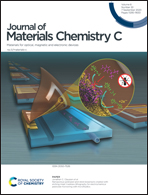Doping-dependent negative dielectric permittivity realized in mono-phase antimony tin oxide ceramics†
Abstract
Materials with negative permittivity have recently become a research hotspot due to their potential applications in electromagnetic shielding, novel capacitance, inductor design, etc. Negative permittivity realized in metamaterials and multicomponent composites are determined by the critical building blocks within them. Herein, from the perspective of intrinsic properties of mono-phase materials, Sb-doped SnO2 (ATO) was synthesized by a hydrothermal method and sintered into mono-phase ceramics to be negative permittivity materials. The influences of Sb-doping on the electric and dielectric properties of the ceramics were studied. It was found that the electron concentration was increased as Sb-doping amount increases in a certain range, leading to the decrease in resistivity. Negative permittivity was observed owing to the plasma oscillations of free carriers derived from donor Sb-dopants. Moreover, the evident dielectric loss accompanied with plasma-like negative permittivity was completely caused by loss of conduction. In addition, reactance analysis revealed that epsilon-negative ceramics were electrically inductive. This work explored the unusual dielectric properties of ATO ceramics and elucidated the mechanism and physical significance of negative permittivity in doped mono-phase ceramics.



 Please wait while we load your content...
Please wait while we load your content...